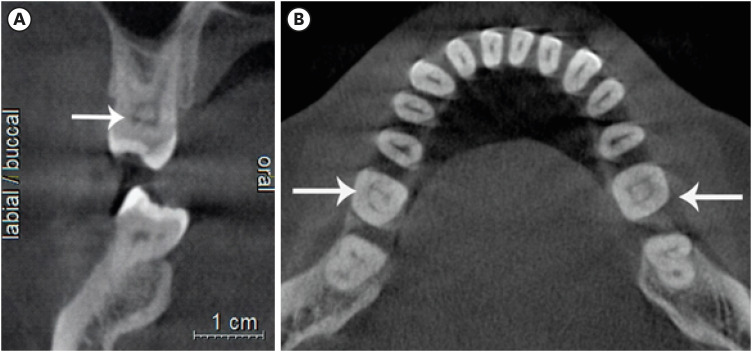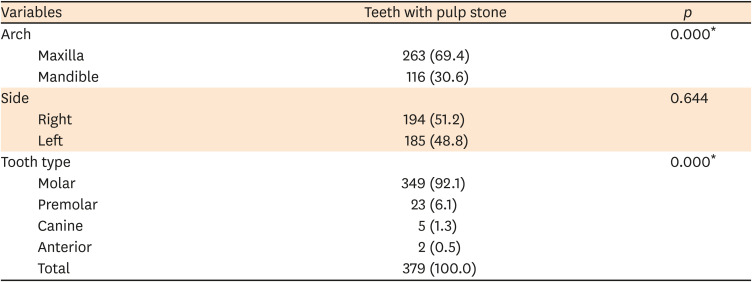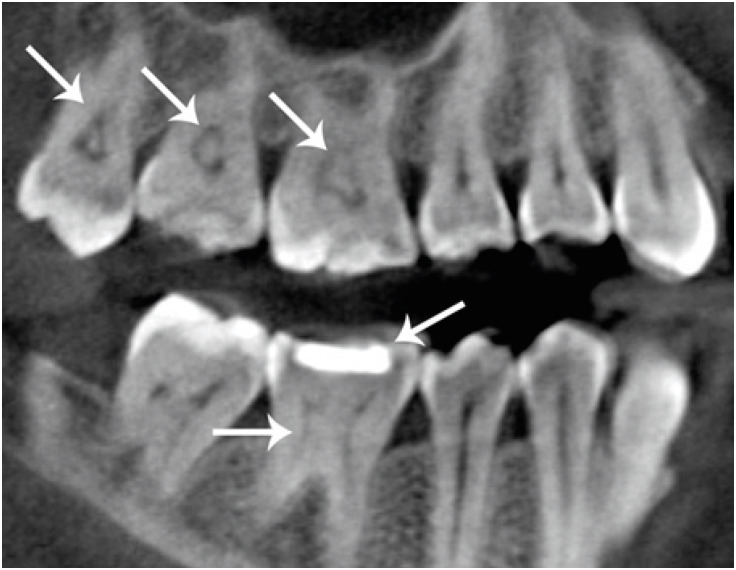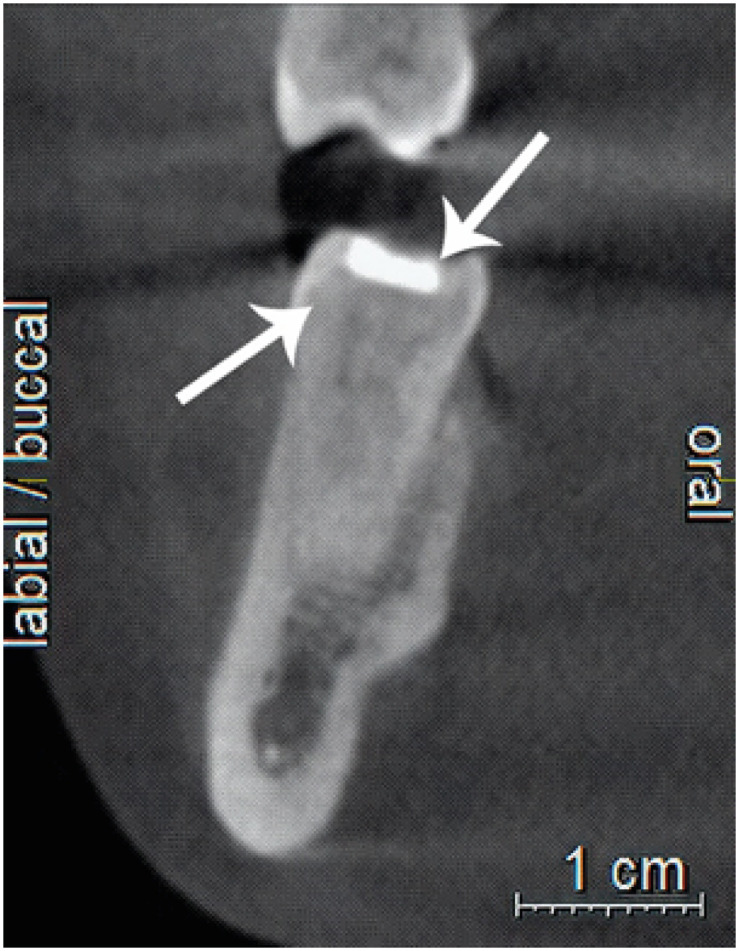1. Bevelander G, Johnson PL. Histogenesis and histochemistry of pulpal calcification. J Dent Res. 1956; 35:714–722. PMID:
13367289.

2. Goga R, Chandler NP, Oginni AO. Pulp stones: a review. Int Endod J. 2008; 41:457–468. PMID:
18422587.

3. Milcent CPF, da Silva TG, Baika LM, Grassi MT, Carneiro E, Franco A, de Lima AAS. Morphologic, structural, and chemical properties of pulp stones in exracted human teeth. J Endod. 2019; 45:1504–1512. PMID:
31757339.

4. Berès F, Isaac J, Mouton L, Rouzière S, Berdal A, Simon S, Dessombz A. Comparative physicochemical analysis of pulp stone and dentin. J Endod. 2016; 42:432–438. PMID:
26794341.

5. Edds AC, Walden JE, Scheetz JP, Goldsmith LJ, Drisko CL, Eleazer PD. Pilot study of correlation of pulp stones with cardiovascular disease. J Endod. 2005; 31:504–506. PMID:
15980708.

6. VanDenBerghe JM, Panther B, Gound TG. Pulp stones throughout the dentition of monozygotic twins: a case report. Oral Surg Oral Med Oral Pathol Oral Radiol Endod. 1999; 87:749–751. PMID:
10397671.
7. Zeng JF, Zhang W, Jiang HW, Ling JQ. Isolation, cultivation and initial identification of Nanobacteria from dental pulp stone. Zhonghua Kou Qiang Yi Xue Za Zhi. 2006; 41:498–501. PMID:
17074192.
8. Nayak M, Kumar J, Prasad LK. A radiographic correlation between systemic disorders and pulp stones. Indian J Dent Res. 2010; 21:369–373. PMID:
20930347.

9. da Silva EJNL, Prado MC, Queiroz PM, Nejaim Y, Brasil DM, Groppo FC, Haiter-Neto F. Assessing pulp stones by cone-beam computed tomography. Clin Oral Investig. 2017; 21:2327–2333.

10. Sener S, Cobankara FK, Akgünlü F. Calcifications of the pulp chamber: prevalence and implicated factors. Clin Oral Investig. 2009; 13:209–215.

11. Hsieh CY, Wu YC, Su CC, Chung MP, Huang RY, Ting PY, Lai CK, Chang KS, Tsai YC, Shieh YS. The prevalence and distribution of radiopaque, calcified pulp stones: a cone-beam computed tomography study in a northern Taiwanese population. J Dent Sci. 2018; 13:138–144. PMID:
30895109.

12. Chaini K, Georgopoulou MK. General pulp calcification: literature review and case report. Endod Pract Today. 2016; 10:69–75.
13. Kannan S, Kannepady SK, Muthu K, Jeevan MB, Thapasum A. Radiographic assessment of the prevalence of pulp stones in Malaysians. J Endod. 2015; 41:333–337. PMID:
25476972.
14. Turkal M, Tan E, Uzgur R, Hamidi M, Colak H, Uzgur Z. Incidence and distribution of pulp stones found in radiographic dental examination of adult Turkish dental patients. Ann Med Health Sci Res. 2013; 3:572–576. PMID:
24380011.

15. Patel S, Durack C, Abella F, Shemesh H, Roig M, Lemberg K. Cone beam computed tomography in Endodontics - a review. Int Endod J. 2015; 48:3–15. PMID:
24697513.
16. Lari SS, Shokri A, Hosseinipanah SM, Rostami S, Sabounchi SS. Comparative sensitivity assessment of cone beam computed tomography and digital radiography for detecting foreign bodies. J Contemp Dent Pract. 2016; 17:224–229. PMID:
27207202.

17. Colak H, Celebi AA, Hamidi MM, Bayraktar Y, Colak T, Uzgur R. Assessment of the prevalence of pulp stones in a sample of Turkish Central Anatolian population. ScientificWorldJournal. 2012; 2012:804278. PMID:
22645455.
18. Ranjitkar S, Taylor JA, Townsend GC. A radiographic assessment of the prevalence of pulp stones in Australians. Aust Dent J. 2002; 47:36–40. PMID:
12035956.

19. Verma KG, Juneja S, Randhawa S, Dhebar TM, Raheja A. Retrieval of iatrogenically pushed pulp stone from middle third of root canal in permanent maxillary central incisor: a case report. J Clin Diagn Res. 2015; 9:ZD06–ZD07.

20. Ibarrola JL, Knowles KI, Ludlow MO, McKinley IB Jr. Factors affecting the negotiability of second mesiobuccal canals in maxillary molars. J Endod. 1997; 23:236–238. PMID:
9594773.

21. Kayal RA. Distortion of digital panoramic radiographs used for implant site assessment. J Orthod Sci. 2016; 5:117–120. PMID:
27843885.

22. Moss-Salentijn L, Hendricks-Klyvert M. Calcified structures in human dental pulps. J Endod. 1988; 14:184–189. PMID:
3077408.

23. Tassoker M, Magat G, Sener S. A comparative study of cone-beam computed tomography and digital panoramic radiography for detecting pulp stones. Imaging Sci Dent. 2018; 48:201–212. PMID:
30276157.

24. Patil SR, Ghani HA, Almuhaiza M, Al-Zoubi IA, Anil KN, Misra N, Raghuram P. Prevalence of pulp stones in a Saudi Arabian subpopulation: a cone-beam computed tomography study. Saudi Endod J. 2018; 8:93–98.

25. Arys A, Philippart C, Dourov N. Microradiography and light microscopy of mineralization in the pulp of undemineralized human primary molars. J Oral Pathol Med. 1993; 22:49–53. PMID:
8445542.

26. Gulsahi A, Cebeci AI, Ozden S. A radiographic assessment of the prevalence of pulp stones in a group of Turkish dental patients. Int Endod J. 2009; 42:735–739. PMID:
19549152.

27. Tamse A, Kaffe I, Littner MM, Shani R. Statistical evaluation of radiologic survey of pulp stones. J Endod. 1982; 8:455–458. PMID:
6958783.

28. Alaçam T. 31. Geriatrik endodonti. In: Endodonti. Ankara: Özyurt Matbaacılık;2012. p. 1178.
29. al-Hadi Hamasha A, Darwazeh A. Prevalence of pulp stones in Jordanian adults. Oral Surg Oral Med Oral Pathol Oral Radiol Endod. 1998; 86:730–732. PMID:
9868733.

30. Cunha-Cruz J, Pashova H, Packard JD, Zhou L, Hilton TJ. for Northwest PRECEDENT. Tooth wear: prevalence and associated factors in general practice patients. Community Dent Oral Epidemiol. 2010; 38:228–234. PMID:
20370807.

31. Elvery MW, Savage NW, Wood WB. Radiographic study of the broadbeach aboriginal dentition. Am J Phys Anthropol. 1998; 107:211–219. PMID:
9786335.









 PDF
PDF Citation
Citation Print
Print





 XML Download
XML Download